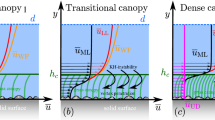Abstract
This study is focused on the effects of ecological factors (diameter and flexibility) and vegetation community composition on the drag coefficient related with vegetation. The single leafy shrub and three mixed communities (including shrub-grass, shrub-reed and reed-grass community) were studied. The flow velocity and water level were measured and used to calculate the drag coefficient based on the Bernoulli’s equation, Darcy drag formula and the expression for the drag coefficient related with Darcy drag factor. The trend of the drag coefficient in the vertical direction was analyzed against flow depth, diameter, diameter Reynolds number, flow depth Reynolds number and relative roughness height in different discharges. The results show that beside the dense leafy shrubs community, the vertical trend of the drag coefficient among other cases against flow depth, diameter, diameter Reynolds number, flow depth Reynolds number and relative roughness height can be approximately expressed by power law functions under different flow discharges. Moreover, in a mixed community with two plants with distinctly different ecological factors, the one with the most distinct variations of ecological factors determines the vertical trend of the drag coefficient; the other one only affects the magnitude of the drag coefficient. Furthermore, if the ecological factors of the vegetation in the vertical direction are kept almost not changed, the drag coefficient can be approximately regarded as a constant.
Similar content being viewed by others
References
NIKORA V., LARNED S. and NIKORA N. et al. Hydraulic resistance due to aquatic vegetation in small streams: Field study[J]. Journal of Hydraulic Engineering, 2008, 134(9): 1326–1332.
NEPF H. M., VIVONI E. R. Flow structure in depth-limited, vegetated flow[J]. Journal of Geophysical Research, 2000, 105(C12): 28547–28557.
YEN B. C. Open channel flow resistance[J]. Journal of Hydraulic Engineering, 2002, 128(1): 20–39.
DARBY S. E. Effect of riparian vegetation on flow resistance and flood potentia[J]. Journal of Hydraulic Engineering, 1999, 125(5): 443–454.
WU Y., FALCONER R. A. and STRUVE J. Mathematical modeling of tidal currents in mangrove forests[J]. Environmental Modelling and Software, 2001, 16(1): 19–29.
WU Fu-Sheng. Characteristics of flow resistance in open channels with non-submerged rigid vegetation[J]. Journal of Hydrodynamics, 2008, 20(2): 239–245.
LIU Cheng, SHEN Yong-Ming. Flow structure and sediment transport with impacts of aquatic vegetation[J]. Journal of Hydrodynamics, 2008, 20(4): 461–468.
GU Feng-feng, NI Han-gen and QI Ding-man. Roughness coefficient for Unsubmerged and submerged reed[J]. Journal of Hydrodynamics, Ser. B, 2007, 19(4): 421–428.
ZHANG Jian-tao, SU Xiao-hui. Numerical model for flow motion with vegetation[J]. Journal of Hydrodynamics, 2008, 20(2): 172–178.
JÄRVELÄ J. Flow resistance of flexible and stiff vegetation: A flume study with natural plants[J]. Journal of Hydrology, 2002, 269(1-2): 44–54.
KADLEC R. H. Overland flow in wetlands: Vegetation resistance[J]. Journal of Hydraulic Engineering, 1990, 116(5): 691–706.
WU F. C., SHEN H. W. and CHOU Y. J. Variation of roughness coefficients for unsubmerged and submerged vegetation[J]. Journal of Hydraulic Engineering, 1999, 125(9): 934–942.
MUSLEH F. A., CRUISE J. F. Functional relationships of resistance in wide flood plains with rigid unsubmerged vegetation[J]. Journal of Hydraulic Engineering, 2006, 132(2): 163–171.
JONATHAN K. L., LISA C. R. and HARRY L. J. et al. Drag coefficients for modeling flow through emergent vegetation in the Florida Everglades[J]. Ecological Engineering, 2004, 22(4–5): 237–248.
Author information
Authors and Affiliations
Corresponding author
Additional information
Project supported by the China National Funds for Distinguished Young Scientists (Grant No. 50925932), the National Key Technology R and D Program in the 11th Five Year Plan of China (Grant No. 2009BAB29B09), the State Key Laboratory of Hydroscience and Engineering, Tsinghua University (Grant No. 2008-ZY-5) and the National Key Basic Research Project of China (973 Program, Grant No. 2006CB403304).
Biography: HUI Er-qing (1977-), Male, Ph. D.
Rights and permissions
About this article
Cite this article
Hui, Eq., Hu, Xe., Jiang, Cb. et al. A Study of Drag Coefficient Related with Vegetation Based on the Flume Experiment. J Hydrodyn 22, 329–337 (2010). https://doi.org/10.1016/S1001-6058(09)60062-7
Received:
Revised:
Published:
Issue Date:
DOI: https://doi.org/10.1016/S1001-6058(09)60062-7




